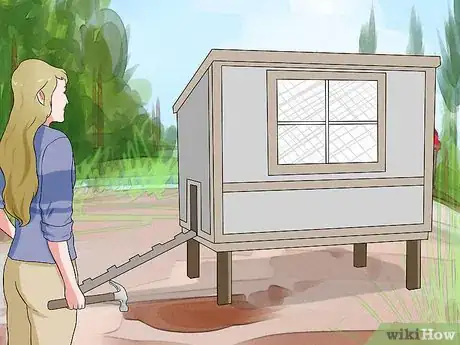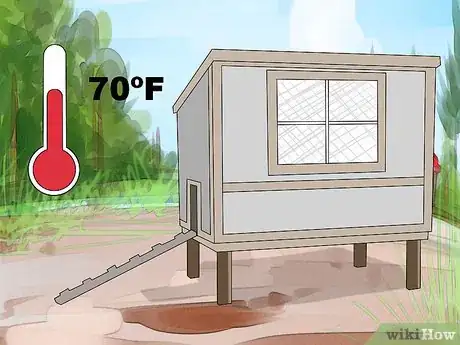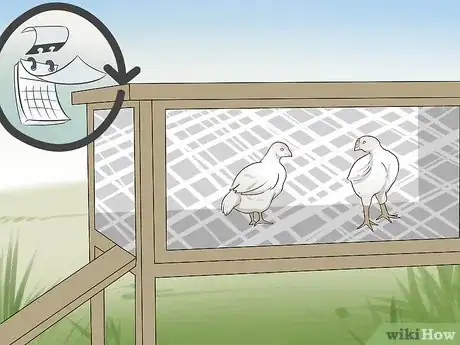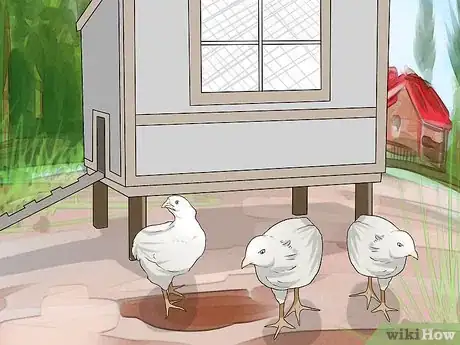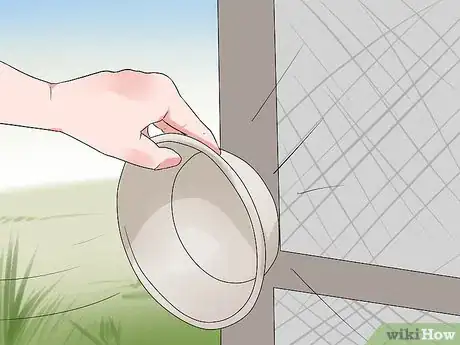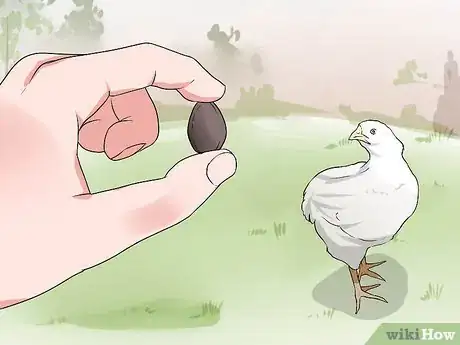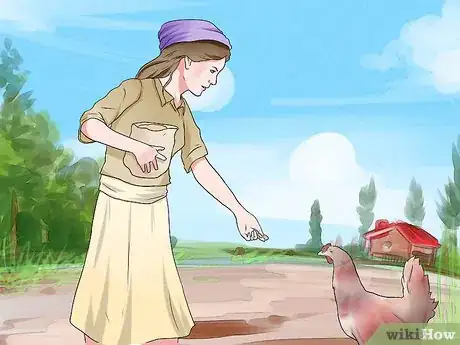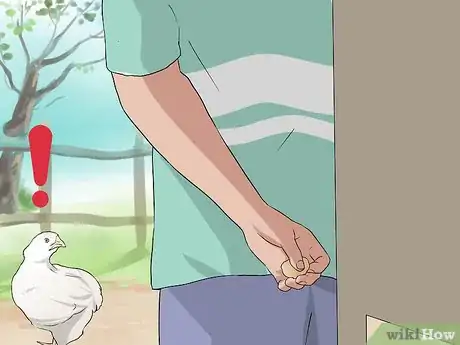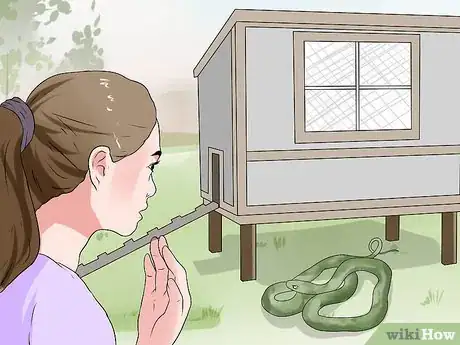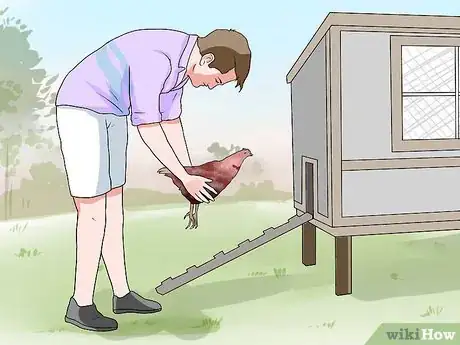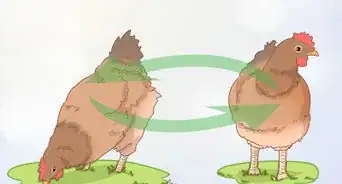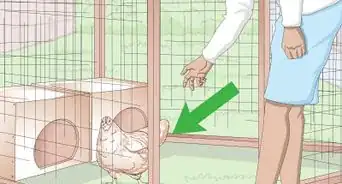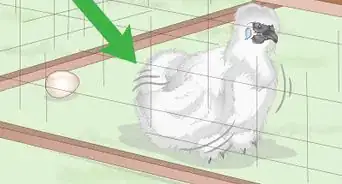This article was co-authored by Amy Harrison, a trusted member of wikiHow's volunteer community. Amy Harrison has over five years of experience working directly with poultry. She has worked on a rural chicken farm built around marketing free-range eggs, where she managed the care for the poultry year-round. She has experience breeding chickens and quail, caring for newborn poultry, handling their health issues, and managing their dietary needs.
This article has been viewed 99,281 times.
Learn more...
Training your chickens to return to their coop is a great way to protect your chickens from predators. Chickens that have established the coop as their home will return to it naturally each evening. You can also train your chickens to return to the coop when you call them in case you spot a daytime predator or need to clean their area of the yard. Chickens do not learn as quickly or as easily as dogs do, but with a little patience you will find that training chickens to return to their coop is fairly easy to do.
Steps
Coop Training Your Chickens
-
1Prepare your chicken coop. Before you can train your chickens to return to the coop in the evening, you need to ensure the coop is set up properly for your chickens. A basic chicken coop should provide at least twenty-four square feet of space and multiple places for chickens to perch.[1]
- Make sure there is a plentiful supply of food and water inside the chicken coop.
- Wood beams mounted horizontally can provide good perching space for chickens.
- If you are raising chickens for egg production, make sure there are enough chicken nesting boxes for each hen (usually one box per four hens will suffice).
-
2Check the temperature inside the coop. Coop training requires that you keep your chickens inside the coop for a prolonged period of time. It’s important that you make sure your chickens won’t be too hot or they could suffer from health issues.[2]
- Your chicken coop should not exceed 70 degrees Fahrenheit during coop training.
- Install fans to reduce the temperature of your coop if it is too hot.
- You may want to consider relocating your chicken coop to a shadier area of your yard if high temperatures continue to be an issue.
Advertisement -
3Keep your chickens confined to the coop for a week. Chickens are often stressed by a transition from one coop or yard to another. Young chickens that are transitioning into living in a coop may take even longer to adjust. Forcing the chickens to remain inside the coop for a week will force them to roost in the coop and begin to consider it a home.[3]
- Make sure your coop allows you to easily replace food and water dishes without allowing the chickens to escape the coop. Most coops have small doors designed specifically for this purpose.
- The bedding at the bottom of the coop will be very messy after a week, so make sure to remove soiled bedding at the completion of the week.
-
4Allow the chickens to leave the coop after a week. After a week, open the door to the coop and allow the chickens to wander out into your yard or the area you have fenced in for them. Try not to interfere with them and instead allow them to wander freely.[4]
- If the chickens do not return to the coop at dusk, it means they have not properly adjusted to it.
- You may have to confine the chickens to the coop for another week in order to ensure they accept it as their home and a safe area.
- Once the chickens have adjusted to the coop as their new home, they will return to it naturally when they sense danger, want to rest, or at sundown each day.
Training Your Chickens to Come When You Call
-
1Choose one consistent sound as your call. Chickens are not as skilled at interpreting human sounds as dogs are, so it’s important that you choose one distinct sound as your chicken call. Using a consistent sound of any sort may work, but by using a tool instead of your voice, others can call the chickens for you if you aren’t present to call them.[5]
- A whistle or bell are both excellent options to use as a chicken call. You could also try banging a bowl or cup on the side of the coop.
- If you choose to use your voice, make sure it is a distinct sound that you do not make regularly when not calling your chickens.
-
2Use treats to train your chickens. You will need to train your chickens to associate the sound of your chicken call with getting a treat in order to get them to come whenever you call. Choose a treat that your chickens do not normally eat otherwise they may grow tired of the treat.[6]
- Bird seed mixed with meal worms serves as an excellent treat that you can spread around inside the coop each time you sound the chicken call.
- Watermelon wedges also serve as good chicken treats, but because they are hard to scatter the less dominant chickens may not be able to get to the treats.
-
3Let the chickens see you with the treats. As you train your chickens to respond to your chicken call, make sure they can see the bag or box of treats as you approach and make the sound. Your chickens do not necessarily need to see the treats for the training to work, but it will often go faster if they see the treats during the early stages of training.[7]
- Let the chickens see you approach their coop with the treats as you prepare to sound your chicken call.
- Chickens will come to associate your behavior with getting treats as well as the call itself.
-
4Use your chicken call and toss treats into the coop. By scattering treats into the coop while you use your chicken call, you will help the chickens begin to associate the sound with both treats and returning to their coop.[8]
- Repeat this process two to three times per day for about a week to establish the pattern in the chicken’s minds.
- If your chickens aren’t interested in the treats you are using, try switching to bits of corn.
-
5Be patient. Your chickens may not understand the process quickly. You may need to sound the chicken call and make sure they see you distributing the feed a number of times before they start to understand. Early on, the noise will not attract chickens, only the smell and sight of the treats will.[9]
- Once one chicken figures out the process, it will begin to respond more quickly. Other chickens will follow suit soon after to ensure they get a share of the treats.
- Chickens are less likely to respond to this training if they have eaten recently or have only left the coop a short time ago.
-
6Start concealing the treats when you call your chickens. Once your chickens are starting to respond well to the chicken call, start approaching the coop without keeping the treats visible. Once you sound the call, remove the treats from where you’ve hidden them and distribute them like normal.[10]
- Hiding the treats will help ensure the chickens respond to the call and not the visual que of the treats.
- If your chickens become accustomed to coming without seeing treats, that is one step closer to simply coming when they’re called.
- Continue to repeat this process until the chickens return to the coop reliably each time they are called.
Retraining Your Chickens After a Scare
-
1Identify the source of the stressor in the coop. Sometimes chickens that have been coop trained will vacate their coop and refuse to re-enter it. This is often caused by a predator entering the coop or the conditions in the coop being unhealthy for the chickens.[11]
- Look for any areas that a predator could have gained access to the coop and secure it.
- Ensure the coop is relatively clean and the food and water are easy to access. Also check the temperature to make sure it is not exceeding 70 degrees Fahrenheit.
- The stressor that caused the chickens to leave must be identified and resolved prior to retraining your chickens to return to the coop.
-
2Catch your chickens. Once you have made sure the coop is safe for your chickens, you will need to catch or corral them all back into the coop. If your chickens are able to walk around a large yard, it may be difficult to catch them all.
- Try approaching sleeping chickens at night slowly with a flashlight. Don’t shine the light directly on the chickens as it may wake them. Once you’re close, gently pick each chicken up and return it to the coop.
- Use food to distract a chicken during the day, then approach it slowly from behind. Once you are close enough, gently pick the chicken up and return it to its coop.
-
3Confine your chickens to the coop for a week. Once all of the chickens are back in the coop, secure the coop and keep the chickens confined to it for a week. This will re-establish the coop as their safe haven and home in the minds of the chickens.[12]
- Release the chickens again after a week. If they do not return to the coop that night, check the conditions of the coop again to make sure the water and food can be reached by all chickens and the temperature is below seventy degrees.
- Secure the chickens for a second week if they do not begin returning to the coop at dusk and the coop is in good condition.
Community Q&A
-
QuestionMy chickens won't leave the coop during the day. How do I get them to come out and enjoy the fresh air?
 Community AnswerTry to bribe them with feed. If it works, keep giving them feed as a reward. Eventually they will be trained to come out and you won't need the reward anymore.
Community AnswerTry to bribe them with feed. If it works, keep giving them feed as a reward. Eventually they will be trained to come out and you won't need the reward anymore. -
QuestionMy two older chickens take themselves off to bed in the coop. Will my two newer ones follow them or do I have to put them in myself?
 Community AnswerThey should follow the older two, but keep an eye on them for the first week or two and put them in the coop if necessary. They will get the idea fairly quickly.
Community AnswerThey should follow the older two, but keep an eye on them for the first week or two and put them in the coop if necessary. They will get the idea fairly quickly. -
QuestionI have one chicken that won't go into the coop at night. I find her roosting on the fence. What can I do to get her to go inside?
 Community AnswerYou could try to catch her and lock her in the coop and let the others out. She will get to know the coop as a safe place. It would also be a good idea if you started feeding all of the chickens inside of the coop so that your rogue will see the coop as a place of food and (if you feed them at night/afternoon) will go in there at night/afternoon expecting food, allowing you to lock up with all your chickens inside.
Community AnswerYou could try to catch her and lock her in the coop and let the others out. She will get to know the coop as a safe place. It would also be a good idea if you started feeding all of the chickens inside of the coop so that your rogue will see the coop as a place of food and (if you feed them at night/afternoon) will go in there at night/afternoon expecting food, allowing you to lock up with all your chickens inside.
References
- ↑ https://poultrykeeper.com/general-chickens/beginners-guide-to-keeping-chickens/
- ↑ http://www.the-chicken-chick.com/2012/07/coop-training-chickens.html
- ↑ http://www.the-chicken-chick.com/2012/07/coop-training-chickens.html
- ↑ http://www.grit.com/animals/coop-training-new-flock-members-coming-home-to-roost.aspx
- ↑ http://ouroneacrefarm.com/train-chickens-come-called/
- ↑ http://ouroneacrefarm.com/train-chickens-come-called/
- ↑ http://ouroneacrefarm.com/train-chickens-come-called/
- ↑ http://ouroneacrefarm.com/train-chickens-come-called/
- ↑ http://ouroneacrefarm.com/train-chickens-come-called
About This Article
To train chickens to return to their coop, start by using a consistent sound every time you call your chickens, such as a whistle or a bell. After calling your chickens, present them with a treat that they normally wouldn’t get, such as meal worms or watermelon wedges. As the chickens approach, toss the treats into their coop, and repeat the process 2 to 3 times a day to establish the pattern in their minds. To learn how to retrain your chickens after a scare, keep reading!
